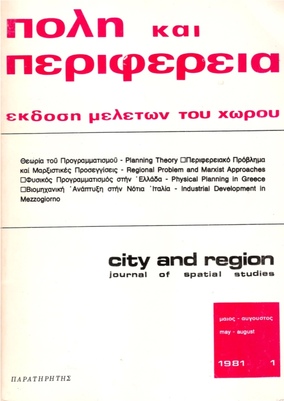[Abstract Title:] urban employment crisis, small firm formation and the concept of spatial structure
Part of : Πόλη και περιφέρεια : έκδοση μελετών του χώρου ; No.13, 1987, pages 141-142
Issue:
Pages:
141-142
Parallel Title:
urban employment crisis, small firm formation and the concept of spatial structure
Section Title:
Περιλήψεις συνεδρίου
Author:
Abstract:
The last 10 years of decline in number of jobs in manufacturing industry has in all the Scandinavian countries been closely associated with scale of residence. The effect of unemployment levels in the larger towns has been substantial, especially in Copenhagen wherel50%of the jobs in manufacturing industry disappeared during the period. At the same time a large proportion of the periphery experienced an unparallelled growth in this sector. Utilising the first set of longitudinal data for the development in all Danish manufacturing firms from 1972-1980, the gross component of the decline and their spatial variation are investigated. This analysis confirms the findings from Scandinavian case studies: only a fraction of the spatial redistribution of jobs is a result of firm migration. More important are the lay-offs in bigger firms - primarily due either to introduction of new labour-saving technologies or to shrinking market shares - and mainly affecting the old industrial centres: the larger towns. Most important in the regional relocation of manufacturing jobs are, however, the spatial differences in the formation of small firms. Evidence on export performance and production technology clearly suggests that these new small enterprises are not only sub-contracting, dependent activity buffers to larger enterprises, but form an important strata in the local production system, crucial to the regional economic restructuring process. While it is beyond doubt the strength of organized labour in the old industrial centres are undermined by the process, the formation of new peripheral small firms is not adequately explained by reference to regional differences in unionization levels, degree of (self-) exploitation, political consciousness etc. Nor do these small firms represent a simple deskilling or polarisation in the labour process. On the contrary it increasingly seems that the unskilled (male and female) labour are the ones who lose out in the contemporaty period of restructuring. The paper argues that only a rigid distinction between (accumulation) process and (geographical) structure makes it possible to analyse the complex interaction resulting in the present reorganisation of industry both spatial and otherwise.
Subject:
Subject (LC):
Notes:
Περιλήψεις των παρουσιάσεων στο συνέδριο της ΛέσβουAbstracts of papers presented at the Lesvos conference




